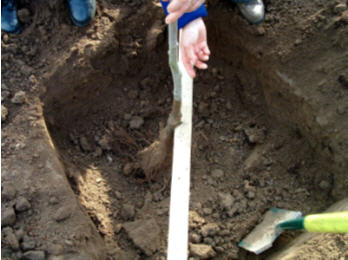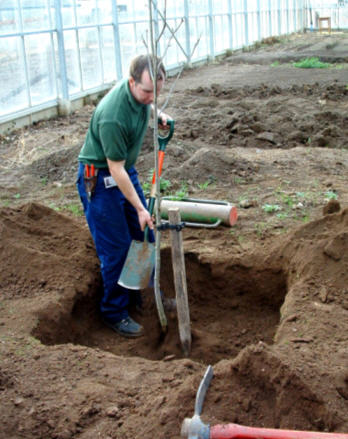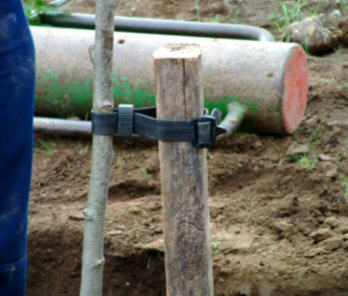Planting a bare root tree -
How to plant a bare root tree and look after it until it is established.
Bare root trees are trees that have been field-grown and then dug up for planting. Their roots have usually been trimmed and they must be kept moist until planted. They are usually only available from late autumn to spring.
Bare root trees can be planted at any time from November to March. Planting at this time gives the trees the cool, damp weather they need to establish a root system before the hot summer weather when their energy will be put into foliage and fruiting. This page tells you how to plant and support a bare root tree until it is established.
If you haven't planted a tree before, you may find it easier to work with a partner the first time.
The tree planted here was a rowan – Sorbus aucuparia - and it was planted in November.
What you will need
Spade
Fork
Stake to tie the tree to
Rubber tree tie
Wheel barrow of well-rotted manure
New Zealand (NZ) planting board (a length of 2x2 with a notch in the middle)
Metal stake sleeve to hammer in the stake
Copious amounts of water
Protective clothing should be worn i.e. steel toe-capped boots, gloves.
Method
After deciding where to site the tree:
-
Push a bamboo stake into the ground and mark out the edges of the hole.
-
Dig a hole, one spit deep and about 1 metre to a side.
-
Place the topsoil in two piles and the subsoil in a separate pile.
-
Be careful to keep the sides straight so that the hole isn't narrower at the bottom than the top.
-
Lightly fork the edges and bottom of the hole to let the roots grow out more easily and provide air holes.
The tree in this example had been temporarily planted so the soil was loosened with a fork from around the roots and carefully removed.
Remember to check the roots for any damage before going any further and trim off any damaged parts with a sharp knife.
-
Lay an NZ planting board across the hole and place the tree in the hole to see if it is the right depth.
The stock of the tree in the example shown is just on the graft mark, the correct depth to avoid the stock sending out shoots.

Once the hole is finished the stake is ready to go in; this is done before planting to avoid root damage.
This stake was to stand about 1 metre above the ground, and vertical rather than angled.
-
Remove the tree from the hole to prevent damage when putting in the stake.
-
One person holds the stake whilst someone else wields the sleeve and hammers it into the ground. Make sure it is both straight and secure.
-
Place the tree next to the stake with the stem being about three inches away.
-
Shovel in some top-soil around the roots. Once the roots are covered, gently firm the soil to make sure it is tucked in around the roots.
-
Add about half of the manure over the top in an even layer. Be careful not to put the manure actually on the roots, since this can cause the roots to rot.
-
Shovel the rest of the top soil in and then add the sub soil.
-
Firm the soil again and dig in the remainder of the manure around the base of the tree.

-
Attach the rubber tie to the stake and then around the stem of the tree. The tie can be held in place by fixing it to the stake with a nail.
-
Finally, dig a channel around the edge of the dug area to stop water running away from the root area.
The tree should then be watered copiously, about once a week, until it is established. This could take a year and you will need to take extra care in hot dry weather so that it doesn't dry out.

After care
Immediately after planting, the tree may need some reshaping to ensure that it grows out in the desired habit and to encourage root growth. If it is not growing and the weather is not frosty, this can be done – lower branches might be removed to raise the canopy or to balance the look of the tree; but be careful not to cut out the leader/main stem or the tree will not grow into its natural shape. Avoid cutting when the tree is actively growing as this will cause sap to leak out.
The tree will need frequent and large amounts of water until it is established.
As the tree grows and the stem thickens, check the rubber tie to see if it needs loosening.
Also check the stake after stormy weather to make sure it is still secure.